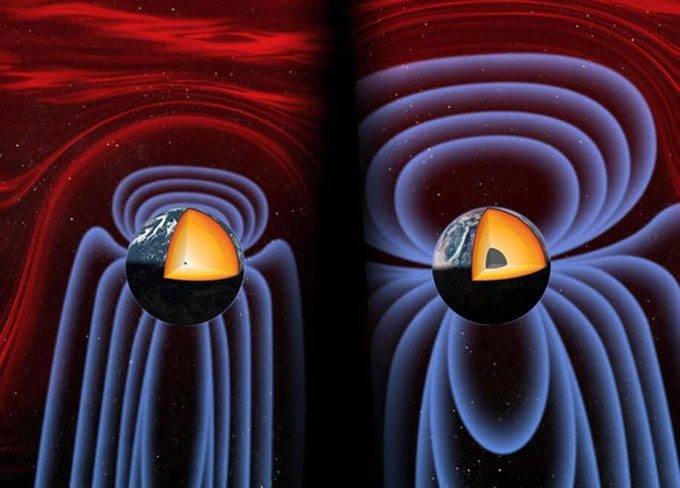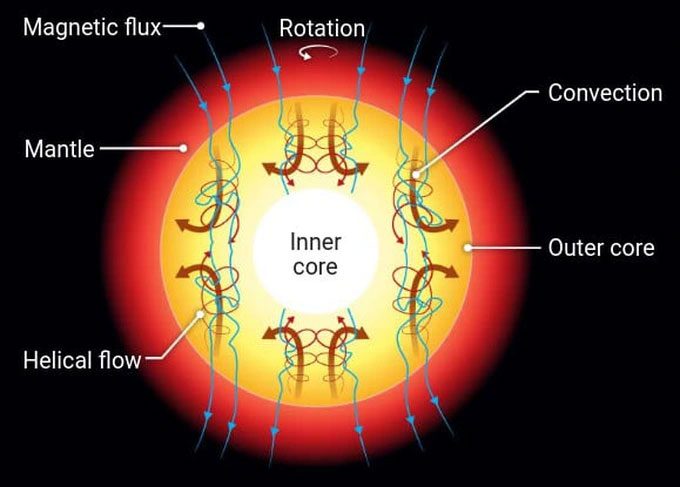The Earth once faced a critical moment when it nearly lost its magnetic “shield,” which protects life on our planet. Fortunately, this shield was revived just in time, prior to the Cambrian explosion.
Our planet contains a solid iron core at its center, surrounded by a thick layer of liquid metal (the outer core) driven by convective movements.

When the geodynamo – the iron in the Earth’s core – reached its tipping point (left side), the formation of the inner core helped replenish our planet’s magnetic field (right side) (Photo: University of Rochester).
These movements create the dynamic effect that generates the Earth’s magnetic field – a protective shield for life, but it hasn’t always been this way.
Approximately 565 million years ago, the intensity of this magnetic field was much weaker than it is today. It wasn’t until the inner core began to solidify that it regained its full strength.
The inner core of the Earth, primarily composed of iron and a smaller percentage of lighter elements, has a diameter of over 2,000 km and is growing at about one millimeter per year.
The outer core – a liquid, acts like a dynamo, maintaining heavier elements in a molten state while lighter elements rise to the surface. The rapid movements of molten iron and nickel alloys, which are conductive, generate the magnetic field.
However, it is important to note that the inner core, also known as the “seed,” is only about 565 million years old, relatively young compared to the age of our planet, which formed 4.5 billion years ago.

The Earth’s magnetic field is generated by convective movements in the molten outer core. The development of the inner core enhances these movements: as iron crystallizes, it releases lighter elements such as oxygen or silicon, which rise towards the mantle, pulling iron along (Photo: C. Bickel).
Researchers believe that a relatively weak magnetic shield and geodynamo formed early in Earth’s history but gradually weakened over billions of years until a critical point 565 million years ago.
When the Earth nearly lost its shield
John Tarduno, a Professor of Physics at the University of Rochester, and his team indicated that the Earth’s magnetic field at that time was less than 10% of its current strength, providing very poor shielding against cosmic and solar radiation.
The formation of this solid sphere at the Earth’s center had a significant impact on surface conditions. During this time, an event known as the “Cambrian explosion” occurred, leading to the sudden appearance of metazoan branches (multicellular organisms) (previously, only simple organisms, primarily single cells, existed).
This unprecedented event marked a major turning point in the evolution of life on Earth. According to Professor Tarduno, the “transformation” of the core certainly contributed to the existence of life today.
In an interview with The Guardian, Tarduno stated: “Our research indicates that the formation of the inner core began about 550 million years ago, right before the Cambrian explosion.“
Once the inner core was formed, its development stimulated movements in the outer core, reviving the dormant magnetic field and providing a protective shield for life. Just 30 million years later, its intensity was equivalent to 70% of its current value.
To better understand this issue, let’s look at Earth’s neighbor, Mars, which lost its magnetic field 4 billion years ago. Without this protection, Mars’ atmosphere was blown away by solar winds, leaving behind a thin layer of gas that results in a dry and lifeless surface today.
Tarduno pointed out: “Earth would not have evolved like Mars, but it would certainly have lost more water than it has today if it hadn’t reignited its magnetic field.“
Additionally, the Cambrian explosion led to the formation of the first large complex organisms, directly influenced by the changes in the geodynamo – iron in the Earth’s core.
There is ample fossil evidence for the Cambrian explosion, peaking around 520 to 540 million years ago. However, these fossils are not numerous enough to definitively determine the cause of this sudden burst of life.
Since the inner core only solidified relatively late in our planet’s history, Tarduno and his colleagues’ research suggests that another mechanism kept the magnetic field active for four billion years.
According to them, this mechanism is based on the chemical precipitation of magnesium oxide. As the Earth’s interior cooled, magnesium oxide could precipitate, creating convection and geodynamics. Once this source was depleted, the magnetic field nearly collapsed completely about 565 million years ago.
One thing is certain: without this phenomenon, we would not be here, and Earth is distinguished from all other planets by its protective magnetic field, making it the only known planet with life.


















































